Adobe® Photoshop® Elements comparison of versions
Photoshop® Elements has undergone many changes since its first introduction 2001. Originally meant to be an alternative to the programs PhotoImpact and PhotoSuite established in those times, it has developed itself to a fully adequate and strong picture processing program. Even the comparison with its big brother Photoshop® CS the program does not have to shun, whereby Photoshop® Elements is far more cheaper and so is affordable for beginners and semiprofessional users.
But Photoshop® Elements by no means is not to be seen as reduced version of Photoshop® CS, because Elements provides many wizards, which make the processing of photos notably easier. Additionally the program contains the well-integrated organizer, with its help you can sort and manage your pictures. By the aid of it you can quickly finish corrections directly in the organizer, without having to start the main program. Nevertheless there are numerous functions, which make the forwarding of your pictures comfortable, be it as CD/DVD, as online album, photo book or as photo print.
In compliance with the current marketing policy of the software-manufacturer Adobe® every year at the beginning of winter a new version of Photoshop® Elements is released. So yet after one has bought a version, this one will be outdated after a short time, at least if one concerns the version number. While initially there were big jumps from version to version according to the scope of functionality and usability, the differences of the newest versions among each other are just marginally. Often for a new release only a few wizards or hidden commands are added. But the fundamental basis of the picture processing functions is set up since many years and practically isn't changed any more.
While Adobe® Photoshop® Elements until version 6 was subject to strong changes and improvements, from version 6 only marginal changes followed. Since version 6 Photoshop® Elements was well-engineered, so we won't go into older versions.
Because we will again and again be asked how every version differs to each other, we have created this site, to determine the most important changes from version to version. We want to give you an understanding of which new functions were added in the course of years and how Photoshop® Elements has developed itself in the following article. For this we introduce for every version - started from version 6 - the most important newly added features and will describe them shortly. Then everyone gets an idea of it by himself, if he absolutely needs the newest version or if an older version is fully sufficient for his intended use.
Table of contents
Adobe® Photoshop® Elements 6
Adobe® Photoshop® Elements 7
Adobe® Photoshop® Elements 8
Adobe® Photoshop® Elements 9
Adobe® Photoshop® Elements 10
Adobe® Photoshop® Elements 11
Adobe® Photoshop® Elements 12
Adobe® Photoshop® Elements 13
Adobe® Photoshop® Elements 14
Adobe® Photoshop® Elements 15
Adobe® Photoshop® Elements 2018
Adobe® Photoshop® Elements 6
The version 6 from Photoshop® Elements was released in October 2007. Besides several new functions, right after the start of the program the most obvious change strikes the eye: The surface was overhauled completely. Beyond that among others the introduction of the new wizard, the expansion of Photomerge as well as the new quick selection shine out.
We begin our version overview with version 6, because this version seems to be very good and mature for the first time through its new user interface. The most important picture processing functions were all on site and the usage was neat and intuitive. In the starting versions 1 to 5 one markedly recognized the working process on it for making it proper picture processing software.
Photoshop® Elements 6 is the last Photoshop® Version, in which can be set that one can get directly to the editor for picture processing right after the start of the program. From the following versions on after the start of the program inevitably the choice window appears, with a selection of picture processing or organizing that means if one wants to start the editor or the organizer.
Therefore I have highlighted this fact in a grey box because to me it appears to be a very useful feature from Photoshop® Elements 6. After the start of the program it only takes 2-3 seconds before one can edit pictures. At the higher versions after some seconds first the choice window for editing or organizing appears and after further seconds who seem to be quite long finally the editor arrives. Admittedly for higher versions one can set up that the editor starts automatically but the program choice window unfortunately can't be disabled like in Photoshop® Elements 6.
Program surface
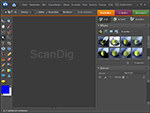
The surface of Photoshop® Elements in version 6 was completely rolled up. The most obvious feature is the darker background, which is intended to direct the focus more on the pictures. Initially the user needs to get used to this but in former times more and more computer programs rebel against the preferences made by windows in the matter of window color respectively they ignore it.
Not to get confused by the number of open pictures, now these can be comfortably grouped together in register cards in the working space. Additionally the processing modes full and quick were put to the right side and were also grouped together in neat register cards. The newly added wizard also adjusts itself to this new classification.
Processing wizard

One of the newly introduced features is the wizard, which complements the processing modes full and quick. With his help ongoing, repeated tasks like color or brightness corrections, extractions of picture elements or the straightening of pictures can be done in the easiest way.
The biggest difference compared to the other processing modes: The wizard comes up with a step-by-step description for every action, which tells the user exactly what he has to do, to get a determined result. The explanation is supplemented through buttons with its help one can directly edit the picture out of the text.
Photo merge: Group picture and faces
Already in the previous version the new Photo merge-function was introduced, with its help one can assemble several pictures to a panorama. In version 6 Photo merge got some improvements: On one side the panorama function was improved, on the other side two new opportunities were added with whom several pictures can be blended together with each other.
The first of them is Photo merge group picture. No matter if one person has closed eyes on one picture or on the next one a person looks to the side - for group photos in most cases always one person has failed to get properly on the photo. Here the new Photomerge group picture-function comes to rescue: Because with this one can distinctly select poses and face expressions from different pictures and combine them on one picture.
Also added was the wizard Photo merge faces. Compared to the other Photo merge-wizards seems nevertheless merely like a function for fun. With its help facial attributes like eyes, ears, nose or mouth can be transferred from one motive to another.
Quick selection-tool

The selection toos were expanded by a new method. By the help of the quick selection a selection can be drawn like using a brush. The therefore applied brush remembers the color areas, which one "painted over" and creates a selection from it. Additionally he supplements the selection by all equal colors automatically, which are adjacent to the selection area.
The quick selection tool is supplemented by the tool option improve border, with its help one can improve the selection afterwards. With simple slide controls a prior created selection can be rounded up, shrunk, enlarged or made smoother.
Convert to black and white
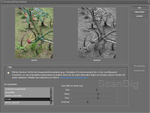
Also new is the possibility to transform a photo into a black and white picture through a wizard. Thereby several preferences are available to the user like "infrared effect", "portrait" or "newspaper", from which one can choose. All these preferences basically differ to each other only how the single color channels red, green and blue are implemented and which contrast is set. The names give you raw indications for this.
If one doesn't like the according preference, each single color channels as well as the contrast can be adjusted together or separately.
The organizer
Also the organizer has experienced some expansions. On one side the correction area has got new functions, which make quick changes on pictures possible for the user without having to start the editor itself. To these the automatically correction of color, tone value, contrast, sharpness or red eyes but also an extraction option can be counted.
On the other side in the area creation the slide show was equipped with new functions. Even if one today hasn't special video software available like for example "Premiere Elements", one now can create picture presentations with over blending's, movement- and zoom effects, sounds or text.
For the organization and management of someone's pictures the area organizing serves, which is located behind the tabulator with the same name. Here the new Smart-Albums were added. With its help one can search for existing pictures in the organizer by reference to diverse criteria like file name, size, alteration date or file format and can summarize them in logical groups.
Adobe® Photoshop® Elements 7
The seventh version of Photoshop® Elements was released in October 2008 and so appeared nearly exactly one year after the sixth version. In the matter of contents there are merely few really new functions. Furthermore these are expansions of the picture processing functions so far. To be highlighted in the first place is the Action Player, which makes predefined actions possible, which contain several single steps, to apply them on one picture. Moreover with the Smart brush-tool a completely new function has been added, with whom filter effects can be applied to a picture quick and easily.
Online-photo album Photoshop.com
One of the most promoted features of the new version surely is the integration of the Online-abilities of Photoshop® Elements 7: With a Basic-Packet, which is completely free, one can store his pictures on an Adobe-Server, share it with others, edit and manage them. 2GB data memory for it are available to the user. Prerequisite is just a registration on the Photoshop-Website photoshop.com.
Furthermore there are also commercial offerings, with which one e.g. can expand his data storage. Additionally the user gets access to so called "Premium-Content", which among others contains new templates or tutorials. This Premium-Service however demands a annual membership against charge. The different opportunities as well as the prices one can get to know on the manufacturer's website.
User interface
The dark user interface introduced in version 6 now can be adjusted in the matter of brightness. So the colors of the program user interface can be adjusted ether even darker or brighter. The font color is adjusted automatically, so that it is still good readable.
This feature was seemingly the reaction of Adobe® to many protests and critics of irritated users, who found the dark user interface to be not only extraordinary but also unpleasant. Finally indeed just Windows should adjust the appearance of windows, fonts and surfaces and not the software, which runs under Windows.
Action Player

One of the most thrilling features of the sevens version surely is the Action Player, which can be found via the wizard in the editing mode. With his help predefined actions, which manually would demand many single steps, can be applied to a picture with a click of the mouse button. By this it corresponds quite exactly to the "Actions-function" of Photoshop® CS.
A drop of bitterness however is existing. One can't create own actions in Photoshop® Elements and first is limited to the delivered ones. Nevertheless one has the opportunity to import actions, which were created in Photoshop® CS, in Elements and so use them. The only prerequisite is that these actions are only allowed to access functions which Photoshop® Elements makes available.
So for owners of Photoshop® Elements this function is only worth it if one can handle the included actions or if one for example downloads finished actions from the Internet to take care of a distinct task.
Photo merge: scene clearing up
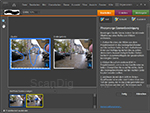
The Photomerge-function also in this program-version experienced an expansion. The opportunity of the scene clearing up is quite similar to the group picture but is merely specialized to scene motives than on groups of human. However also here one can remove or smear away unwanted elements from the picture. Prerequisite for this are several pictures, which were taken from the same viewing angle. A tripod however isn't necessary because Photoshop® Elements aligns the pictures by itself.
Filter: making it dull

Added whole new is the filter making it dull, which lines itself up into the category of the soft drawing filters. Like also for the other filters, here the picture is drawn soft, too. However it is attempted to maintain the sharpness of borders and details. The filter is mainly intended to give portrait photos a silky respectively glamorous look.
By means of this extra function one recognizes how changes of functions often take effect for the many new Photoshop® Elements versions: In one sub topic a new command is added which is similar to the existing ones but still somewhat different. Many Photoshop® Elements users never use a soft drawing filter, so that such a change/supplement is absolutely obsolete.
Smart brush-tool

Also two new brushes are offered by this version of Photoshop® Elements: The Smartbrush-tool as well as the Detail-Smart brush-tool. Both work in principle in a similar way. Initially you can choose between different filter effects and then transfer these by help of the brush to the picture. So the filter won't be applied to the whole picture but only on the overpainted areas.
While the Detail-Smart brush works like a "normal" brush, the Smart brush can choose bigger areas by itself similar to the quick selection. In total one can access 50 different filters for both smart brushes.
Processing wizard: photo graphic effects
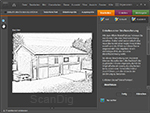
The wizard for picture processing newly introduced in version 6 has gotten an additional expansion. In the category photographic effects one can choose between the new methods old-fashioned photo, saturated slide film or line drawing.
Old-fashioned photo transforms the picture into a black and white picture, for which one can choose between three different versions. Furthermore one can add the color toning. The mode saturated slide film is in principle a correction of contrast and saturation. The line drawing transforms a photo in a kind of cartoon picture. The colors will be nearly completely removed. Outlines will be displayed like a pencil drawing.
Touch Up
For quick corrections the editing-tab quick now has a further sub menu. The area Touch Up allows the user to remove red eyes, bleach teeth, color the dark sky blue or improve the contrast of a black and white picture by a few mouse clicks. Also here the new tool works with a Smart brush, which automatically creates an appropriate selection.
Organizer: Text search

The organizer has gotten a comparable lower supplement. So here now by the help of a text field pictures can be searched according to single catchwords. Prerequisite for this is of course, that the pictures in the organizer are already provided with corresponding key words.
One can nearly quarrel about, if this function is a new feature or more the disposal of a failure of the software. Finally every PC, every database and every Album lives on search functions of various ways, to find contents easily and quick. Such a supplement can be sold good as new feature, but for the user it is merely an understanding, which of course was missed in the predecessor versions.
Adobe® Photoshop® Elements 8
In September 2009 the eighth version of Photoshop® Elements was released. In the opposite to the previous versions in this update only few obvious new things were added. A major part of these changes are improvements of existing functions. The highlights at the same time are the little changes like the possibility to adjust the brush size by using the mouse as well as the New-assemble-tool.
Because of the minority of changes one could version 8 nearly call a kind of bug-fix-version of the predecessor version 7.
Program surface
The expansions of the program surface are inconspicuous on the first sight but however quite useful. Outstanding here is the possibility to alter the size of nearly all tool peaks directly with the mouse. Hold the ALT-key as well as the right mouse button pressed at the same time and after that move the mouse to the left or right, to enlarge or shrink the brush peak.
Also new is, that picture windows now can be moved beyond the program border, this is something from which owners of two monitors will benefit. Beyond that already opened picture windows can be set to the same zoom level or position with one click.
Preferences levels

Minimalistic but practically is also the change of the preferences levels. Different than until now the corrections applied with it aren't created in a separate window, which has to be explicitly opened and closed. Instead you can alter the preferences at every time in an extra tab beneath the layer stack.
New-assemble-tool

A complete new function brings the New-assemble-tool, which shares a place in the tool bar with the extraction tool. By the help of this new tool it is possible to clinch a picture (for example a building in the background), but in the matter of size to take out single parts of the picture (for example human in the foreground).
Regularly the tool recognizes the main motive by itself and takes this one out of the clinching, so that only the uninteresting picture areas are shrunk. In all other cases two special brushes are available for ones use, with whom one can explicitly take out or add picture areas fo the clinching.
The New-assemble-tool can also be called via the wizard tab including a leaded description.
Photo merge: exposure to light
Also new is the Photo merge-function exposure. This one tries to make a new, atmospheric and best possible exposure photo out of two or more different exposure photos - for example one with and another without flash . Like for all Photo merge-functions also here it isn't necessary, that the pictures are taken with a tripod. Photoshop® Elements aligns the pictures to each other by itself.
Organizer: Tag-Cloud
Tags or key words for pictures are nothing new in the organizer. But new is that the key words used in the albums can be assembled to key words in a so called Tag-Cloud. Thereby the words that are most frequently present are highlighted. In that way one can quickly search for frequent or special terms.
The key word function is supplemented by an automatic recognition. This one can be applied to pictures in the organizer and it tries by itself to assign different features to the picture. To this belongs the quality of the pictures or the face recognition. This additionally tries to recognize faces, which belong to the same person, and to assign corresponding key words to them.
Adobe® Photoshop® Elements 9
Also the ninth version of Photoshop® Elements took no more than one year. In September 2010 the version was officially released. This version offers even fewer real innovations than the previous one. At the first place one meets expansions or improvements of existing functions. New and outstanding from the changes are alone the layer masks.
By means of the changes described in the following one realizes, that it nearly makes no difference, if one works with version 8 or version 9 of Photoshop® Elements. If one not yet passionately adores layer masks, he can as well keep on working with version 8 and abandon the new version 9.
Layer masks

Of course they aren't really new: Different functions of Elements have used layer masks already for a long time, but it wasn't possible to the user until then (respectively only on detours) to create own masks. With version 9 now finally also this function is available: By clicking the icon in the layer stack besides the preferences layers one creates quickly and uncomplicated a new Mask.
Photo merge: Style-accordance
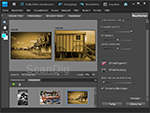
Like in the last versions Photo merge also this time has gotten a new function. With the Style-accordance color styles shall be transferred from one picture to another. For alignment furthermore three sliders are available to the user to control the effect.
In summary this new function seems to be very special and won't quite find a place in all day use, that means from the few Photoshop®-users, who work with Photo merge anyway, only just a minority will benefit from this function.
Photomerge: Panorama
The Panorama function of Photo merge is a member of Photoshop® Elements for a long time. By its help several overlapped taken pictures can be automatically merged to a Panorama. Amendments here are just necessary at the borders, because here are sometimes empty areas are generated due to the "back bowing" of each picture. Until then one had to cut out these with the extraction. The improved Panorama-function in version 9 recognizes such free areas by itself and intelligently tries to fill them up with picture material - if demanded.
Area repair brush: content sensitive
The Area repair brush in version nine of Photoshop® Elements has learned something from his big brother Photoshop® CS. With the option "content sensitive" the tool takes samples of the surrounding of the areas to be repaired by itself. These then will be used to fill the areas to be replaced quite suitable - also for complicated backgrounds.
Processing wizard: Creative editing
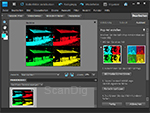
A completely new area is offered by the Processing wizard. Fife new program lead effects can be found here. The Lomo-Effect transforms a picture in a way, as if it was taken with a camera of the same name. By help of the Out-of-Bounds effect a frame can be created and parts of the picture can be defined, which seem to shine out of the frame.
The Perfect Portrait mainly uses existing functions like red eye removal, tooth bleaching or soft drawing filter, to improve portrait photos. The function Pop-Art creates a typical Andy Warhol like picture with a few steps. The last effect mirroring fulfills exactly what the name promises.
Creation and pass on: Picture book and more
In the creation-Tab one now can create with a few clicks calendars, greeting cards or picture books from own photos. Therefore one can access different templates, which automatically establish someone's own pictures. The herewith created picture collections after that one can print out or transfer them via Internet to a printing company, which then commits them to paper.
Organizer: Videos and Facebook
The Organizer also was expanded in this version. So it now can manage also videos from the sister program Premiere Elements.
For all users of Social-Networks like Facebook a function was added, with whom pictures out of the Organizer can be transferred to the own Facebook profile via a click.
Quick editing tab: preview
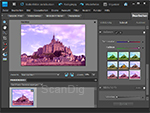
Somewhat hidden is the expansion in the editing mode quick of the editor: Every one of the options has a little arrow at the right border, behind are - if it is flipped open - nine preview thumbnails hidden. Every one of these preview thumbnails contains a default option, how the corresponding correction can be applied.
If one moves over these thumbnails with the mouse, the future changes on the photo are visible. A click with the left mouse button, applies these directly on the picture. Additionally one can also alter the default option with pressed mouse button, by moving the mouse to the left or right.
Adobe® Photoshop® Elements 10
Version 10 of Adobe® Photoshop® Elements was released in September 2011 and so newly maintains the annual cycle of the version update. Again less is done in the matter of real innovations of the tenth version. At least worth to highlight are changes of the Text tool as well as a number of new effects for the Smart brush-tool.
After the changes in the last versions were already quite marginally, it gets more and more remarkable, that Adobe® yet every year releases a new version of its Photoshop® Elements Software, but merely not to stop the annual up counting of the version than to develop the software further. While for other computer-programs a jump in the main version often means a revolution, for Adobe® this is only just a counting of years, which doesn't tell much about the scope of functions. Other software-manufacturers would just count up a sub version for changes that Photoshop®-Elements gets from version to version, so e.g. they would turn version 8.0 into 8.1 or 8.2.
Extraction with cutting rules
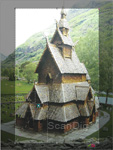
The Extraction-tool in Photoshop® Elements version 10 comes up with an additional option: In the tool options one now can choose between different overlappings, say aiding lines during the extraction.
Here two different rules are at choice for picture creation like the "Golden cut" and the "thirds-rule", as well as a same named raster. These can serve the user as visual orientation to determine which parts of the picture shall be cut off. The picture besides shows the application at the cutting off of a picture in portrait format.
Smart brush
The Smart brush added in Elements version 7, with whom numerous effects can be draws into the picture easily, has got a whole bunch of new possibilities. In total 30 new effects were dedicated to this tool.
Editing wizard

Three new effects are available also for the lead processing of pictures. In the wizard-Tab one now can additionally create a Orton-effect, a picture stack as well as a depth of field.
The blend effect depth of field creates a simple depth (un)sharpness in the picture. Thereby one can choose between the modes simple and user defined. The mode "simple" creates a radial soft drawing, in whom middle lays the focus and it will be drawn sharp. But if one wants to put specific Objects or picture layers in the foreground, one can mark these with the mode "user defined".
The Orton-effect, named after the photographer Michael Orton, creates a softer, smoother picture. Also here the work is done by a soft drawing and additionally the brightness is aligned. The picture stack can create a Collage of single pictures from a photo. One can choose between four, eight or twelve single pictures, from which the final picture shall be put together.
Text tool: Text at shapes

Again and again it was desired by many users and one had to wait long for it: An improvement of the text tool to align letterings at different shapes. Adobe® in version 10 of Photoshop® Elements has already included three new text tools.
By help of the Text-to-selection-tool initially a selection is created, on its border one can after that let text float around. For this the tool by default provides the quick selection tool. But one can also create a selection with all other methods and after that align the text to it.
Quite similar works the Text-at-shape-tool. Here at first one can choose from seven simple forms like rectangle, ellipse or a butterfly and also here align the text at the outlines.
As third opportunity the text tool Text-at-own-path is available. Here one can draw a path into the picture by free hand, which is softened by Photoshop® by itself. After that one can edit the path once again by help of different node points. Also for other tools the text is guided alongside of the path.
Organizer: Visual search function
Like before also the Organizer is expanded again. The new intelligent search function helps the user to search for similar motives or colors. To achieve this one or more reference pictures are stated and the Organizer searches automatically for the appropriate correspondence. By help of a slide control one can define, if it has to be searched merely for colors or shapes.
Furthermore one can choose single picture extractions and search only for special elements which are contained in that. Photoshop® Elements searches for appropriate pictures and additionally marks the area in which the motive occurs for which the search was done.
The search criteria defined by the user furthermore can be stored in a Smart-Album, so that one doesn't have to generate them anew next time. A simple click on the album is enough to get the results on screen again.
Adobe® Photoshop® Elements 11
As it was expected according to the annual release rhythm, in September 2012 Adobes® 11. version of Photoshop® Elements was released. ALso in this year the software has been complemented only by a couple of smaller improvements and gimmicks. So it does not surprise, that many functions have not changed since the version 6. In the following we explain the new features of Adobe® Photoshop® Elements 11. Beforehand one can say fortunately that the complete presentation (toolbars, background etc.) has been brightened significantly compared to the previous versions. Instead of nearly black toolbars Photoshop® Elements 11 now offers a comfortable light grey working environment. And with this change Adobe® returns in some extent a step back towards the beginnings of Photoshop®® Elements.
Illustrations from photos
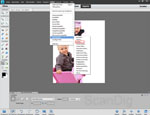
Now you can produce comics and illustrations from your photos per mouse click. Photoshop® Elements 11 contains three new drawing filters: "Comic", "Comicroman" and "Pen and Ink". For photos, which shall be converted in colours, the filter "comic" is suitable. There are four automatic functions which can be applied: Comic, grey steps, sunny day and old print. Additionally you can apply your own settings with 5 scroll bars. "Comicroman" is responsible for black/white illustrations of photos. There are four auto functions available, too: painted grey, fine details, hard edges and distorted plot. With the help of the 4 scroll bars the blackness, appearance, contrast and force can be influenced. Images, which apear as manually drawn, can be produced with the filter "pen and ink". By using lots of adjustable parameters one obtains an individual artwork.
With such a new feature one recognizes clearly, what the annual version steps from Adobe® are: Small functions, which are hidden in any sub menu, are added. The fewest users ever plan to produce a comic out of their holiday photos. Maybe one tests it once and says "nice gag". However, such a function is not a buying criterion. And in a couple of years, when the version has an even much higher number, also this feature is somewhere in the menu and it is one of them, which the normal Photoshop® user never looks at or clicks at, respectively. In view of huge hard drives and memory one hardly recognizes that such features need a lot of memory. Only when starting Photoshop® Elements one realizes that this went much faster earlier...
More intuitive graphical user interface

There are extra large symbols, different modes (fast, assistant, expert) and a tool bar with actions, which facilitate editing and organizing photos. In the fast-mode useful fuctions can be applied with the help of scroll bars and miniature previews. To each of these fuctions there is also an automatic buttom.
The toolbar itself is reduced to the fuctions magic wand, red eyes correction, teeth bleaching, text tools, reparation pen and cutting tool in the fast mode. These are functions, which most Photoshop® users use again and again and which also advanced users apply often. In the expert mode all 24 tools are available.
Clear management
The organizer function, which is already known from the predecessor versions, has been amleriorated in that way, that one can let it show all photos and videos from a certain person, a particular place or a sprcific event. So one certainly does not loose the overview about one's photo archive. That is not a big change; one can almost say it is a bug fix, since a user normally expects such a function from an organizer.
Simple creation of professional effects
In the editor with an assistant there are new options, which one lead step by step through the creation of new effects. Miniature views can be simulated in order to foresee the result in a better way. Effects like an individual vignetting or high key or low key exposures can be created. Last ones are usefull in order to make pictures appear dynamically or dramatically.
Original compositions from several photos
Collages or cutting of image parts works in this version of Photoshop® even simpler. Even filigree image parts like hair can be separated very easily. With original image composition and collages you can impress very much.
Assignment on a map
With this new function by Adobe® you can review your holiday trip in another way. Thanks to the recording place tags you can easily reconstruct on a map, where the photos and videos have been made.
New masters for greeting cards, calendars etc.

The text birthday comes shortly and you still need invitation cards? Thanks to the new masters you can create very quickly and comfortably invitation cards, thanksgiving cards, photo books or calendars. You can choose from a great variety of fomrs, graphic arts, frames and texts. From wooden frames over pearl frames up to flower frames everything can be found. Also very plain frames can be used. With the graphic arts and the forms you can create funny scenes again and again.
The creation of invitation cards etc. has not to to all too much with normal image editing, however, it is a functionality, which some Photoshop®-users can make use of very well. What up to no has been done painfully with copy and paste, cut etc., now it works almost fully automatically. And an invitation card for a birthday event is needed by everyone again or again, right?
Additional creative possibilities
The functional scope of Adobe® Photoshop® Elements 11 offers great possibilities for expanding the included effects, styles etc. You can import actions for the automatization of standard jobs, for example, from photo platforms oder blogs. An example, how to import an action and use it for one's image editing purposes can be found in our tutorial Exchange image background - extracting with colour channels. In that tutorial an action created with Photoshop® CS is used in order to expand the funcionality of Photoshop® Elements by an important feature "colour channel".
Honestly said, 99% of all Photoshop® users will never download or use an action from the internt, since most of the Photoshop® users don't even use the basic functionality of the program completely and don't think at expansions at all.
Video upload on Vimeo® and professional photo print
You can share your videos with friends or the whole world with a few mouse clicks. The online portal Vimeo® is the right platform, and thanks to the cooperation with Photoshop® everything goes much simpler.
If you prefer a printed form of your photos, you can upload then on the CEWE website directly from Photoshop® Elements and can order prints, posters or photo books for delivery at home (this service varies from country to country).
Adobe® Photoshop® Elements 12
Like every year in autumn ® brought also in the year 2013 a new version of its imaging editing software Photoshop® Elements on the market. As usual there are a couple of innovations; the main part, however, is equal to the predecessor version. Noticeable is mainly the mobile connection to smart phones and tablets and a couple of new tools. Furthermore Apple users can be glad: Photoshop® Elements 12 is now available in a 64 bit version, which was up to now only available for windows. So the software will run a bit more fluently.
The graphical user interface equals to that of the predecessor and is easy to use. As already known there are three possibilities to edit images. Whether you choose the mode "fast", "assistant" or "expert" is up to you. Adobe® has observed the behaviour of the users in detail. Filters and effects have been arranged newly. Often used colour filters, for example, are now arranged better, so that they can be found with only one click.
Dividing and synchronizing pictures

Nowadays more and more often smart phones and tablets are beeing used to make photos instead of cameras. By the new function of Photoshop® now it is possible to access images on all your devices and share them. There fore the gratis App Adobe® Revel has do be downloaded. Similar like Fotostream from Apple on the PC all images, which have to be transferred to mobile devices, must be shifted into one folder. Pictures will be synchronized directly and are immediately available on each device. Backwards images from the smartphone can be shifed into the mobile library with the free app and are so visible on the desktop. Furthermore on the mobile phone a couple of simple effects can be applied, similar to Instagram.
Correction of flash light at animal pictures
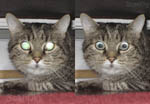
What was only possible fot the human eye up to now, now also works with animals thanks to Photoshop® Elements 12. Within the known red eyes correction tool there can be activated a checkbox so that to tool knows that the eye of an animal has to be corrected.
So the over exposed eyes of a domestic animal should be recognizable by one click. In practice one becomes rather disappointed. The eyes look unnatural and the tool does not really recognize if it is an eye or not. For example, when clicking at the snout of a cat there will be an eye after applying the tool. Furthermore the tool does not recognize the eye colour of an animal. After processing the eyes are always grey.
Content sensitive shifting
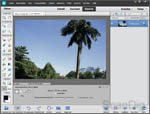
The most spectacular innovation is the content sensitive shifting. With this tool it is possible to select singular image elements and shift them within the picture. Photoshop® fills the gap, which arrises in the background, with surrounding pixels. The program takes pixels which lie near the selected part. How good that works depends on the motive and the background.
In practice you will realize that the function works well for simple motives, which lie on a unicoloured background. As soon as there are other objects in the background, they will be deformed and the image will be destroyed. For beginners of the digital image editing this tool is usefull nevertheless.
New effects and filters
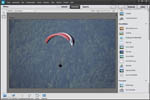
With the "zoom burst" effect static images become dynamically. You can give your images a kind of movement with this function. However, this effect is nothing more than a radial diffuser, with which you also can set the strength of the effect, which is not possible within the new "zoom burst" effect. Anyway, it is an interesting news for beginners.
Aligning skew photos in the expert mode now is even more simple. You just draw a line to which the image will be aligned. The gaps, which usually arrise in the background, will be filled automatically by Photoshop®. If this works successfully depends on the motive.
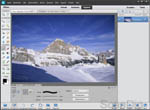
With the effect "photo pusszle" you can make a puzzle out of an arbitrary photo. However, it is only an optical game. After switching in the assistant mode you can first choose the size of the puzzle parts. Then it is even possibile to take out a single part from the puzzle and transform it arbitrarily. It might be a nice idea for the next photo card for relatives and friends. Now you only should have a printer which does not print the complete puzzle, but produces the singule pieces of the puzzle piece by piece...
Another innovation is the intelligent hue processing. It remembers your colour preferences. When using that effect there will be a controller in the middle of the image, which can be moved in any edge of the screen. So it is possible to brighten or shade the image or give it more contrast.
Adobe® Photoshop® Elements 13
In September 2014, abiding to the product cycle, Adobe®, released yet again a new version of the image editing Program Photoshop® Elements. As was the case with past upgrades, the new software offers mainly detail modifications compared to the preceding version.
There are no fundamental changes to be found - which is a good thing; users switiching from version 11 or 12 won't have to adjust themselves. Instead, version 13 is just as overseable and visceral as the last ones. Few user will notice all technical changes. Besides some new functions, it's mainly the functionality in the background that has been changed: the newest camera - and pc-hardware is now fully supported.
Users working with high-resolution screens of the newest generation for Windows (HiDPI-monitors) and Mac (Retina-Displays) will be delighted to hear that problems with tiny buttons and scaling issues are now a thing of the past because version 13 can finally deal with the high pixel density and high resolution of the new generation monitors.Adobe® Camera Raw (ACR) Version 8.6 in included in Adobe® Photoshop®. Furthermore, the manufacturer provides regular updates, by this time reaching version 8.7.1. On the downside, version 13 has degraded in some aspects... some functions that used to be part in older versions have now been cancelled, system requirements have naturally risen - and in the course of that, support for some older systems has been dropped.
After succesfully instlling Adobe® Photoshop® Elements 13, the user is present with the known option of choosing between organizer and editor. By clicking the wheel in the upper right corner of the display, the user can predefine this choice for future starts of the program.
Upon starting the program for the first time, new functions of the software are presented to the user in two columns - overview and innovations, thus giving a first impression of what's new. The following report deals with these innovations. Beforehand, some helpful information to users upgrading from an older version of Photoshop® Elements: The old catalogue can be automatically optimized for use with the new version. This function is compatible back to Version 6.
Users looking for a software to process and optimize digital photos or scans, will quickly notice that, based on the new features described hereinafter, an update to version 13 is unnecessary as all such tasks can be easily accomplished using an older version of the software, such as Elements 8 or 9.
Cropping: 4 "intelligent" proposals

Upon choosing the cropping-tool in the quick-mode, the program will automatically provide four different proposals for cropping the image. According to Adobe®, the contents of the image are withal being analyzed to the effect that important elements such as persons are not being cut. This actually worked well in our test, given that the respective image structure. Large, areal, colorwise coherent elements are usually being recognized as such by the software. Naturally, the feature won't work as well in the case of pictures that are lacking such concise elements.
Photomerge composition
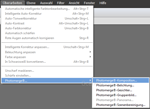
The functionaliy of photomerge ® has yet again been extended and improved. Adobe® pledges that, using the new feature, elements and persons can be easily extracted in one - and pasted into another photograph. Supposedly, even the individual users' preferences are being gradually adapted and implemented. In practice, this learning component was lacking. What's more, the function cannot replace human skills. Inssuficient know-how cannot completely compensated by a program. Subsequently, we shall check ot Photomerge® more thoroughly: By means of a montage, we'll illustrate some more of the innovations of version 13.
Editing and enhancing selections
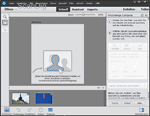
Editing and enhancing of of selections is now possible even after the selection has been completed. Here, you can check it out in the process of a photomontage. To the right side of the image, every step of the process is explained. If both pictures are open, first, one of them is dragged onto the canvas. Next, using a selection tool such as the magic wand, the desired part is marked. After, the selection can be cahnged using the "outline" tool. When doing so, the display changes to a masking view. Until here, in principle, all is the same as in earlier versions of ® Photoshop®.
The third tool we're going to use in this example is called "refine edge" and is part of an innovation introduced in version 13: within the tool, the user may choose between "add", "substract" and "push", "smoothen". By "push", the edge can be pushed outwards or inwards, and the edge is seemingly elastic. The function "smoothen" is useful in case the selection has been made manually using the mouse. The resulting uneven edge can now be smoothed out using the "smoothen" brush.
Enhance edge
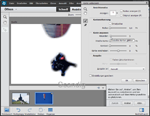
The selection can be further specified through the button "refine edge (advanced)". Upon clicking this button, a menu called "refine edge" will open, in which the edge can be influenced by brush strokes and etching. Besides, there are various other options available. With some practice and skill, it's a waltz to adjust the controls precisesly for any kind of object. Meanwhile, the different viewing modes are very helpful in the process. Incidentally, we would like to point out that this function is availble in all three editing modes.
Shift-scale & mask & adjusting hues
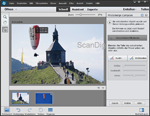
In the animation to the right, the third and fourth step of the photomerge-composition are displayed. First of all - in the third step - the pasted object is moved to the desired spot using the function shift/scale. Thereafter, using the buttons "mask" and "reveal", some last alterations can be made to the selection with brush strokes. Using the three controls, size, opacity and hardness of the brush can be defined, enabling partial transparency and fluent passages between the pasted object and the background.
In the last step, we are matching the colors of the object to those of the background. The software can supposedly match the tone automatically. In our example, this did not work well, resulting in an extreme contrast on the edges. Presumably, this will work better in the case of homogenous transitions between object and background. Just like all other auto-functions, this tool should also be treated with caution. It's advisable to adjust the controls by hand. Since luminance, contrast, temperature and saturation can be individually adjusted, object and background can be precisely matched.
Content-aware filling
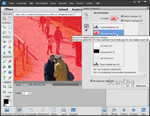
In this working step, we are checking out the newly introduced function "content-aware filling", which empowers the user to remove certain parts of the image, while filling the remaining area in a content-aware manner. First, two areas of the image have be marked, then the selection is refined using the menu "refine edge". Once the selection is complete, the function "fill selection" is revoked, eg. by right-clicking on the selection and choosing the function from the dropdown menu. There are several modes at hand for filling the selection, the opacity can be regulated. In addition, the user may choose to leave out transparent areas.
The results of this funcion vary from time to time. The problem is obvious: the program analyzes the entire picture concerning colors, edges and structures. Thus, it might happen that the selected area will be replaced by an image section that is not matching at all points. As a result, consensus of color, structure or edge difinition might be poor.
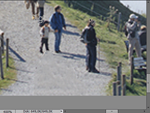
In the alongside example to the right, the content-aware filling function has been applied to two previously marked areas: In one case, the filter works flawlessly. The headlights, surrounded by mostly homogenous, unstructured sky, are conveniently brushed out. In the other case, the filter is stretched to its limits. The two individuals, surrounded by patterned ground are successfully removed, the subsequent filling of the remaining area however is not that plausible.
In a third step (not shown in this test report), an area consisting of green trees was removed from a landscape photograph. The remaining image section was auto-filled with a patch of blue sky originated from a completely differenct part of the image.
Assistant: extended instructions, new filters
In the mode "assistant", new filters are introduced in Photoshop ® Elements Version 13 and some of the instructions have been extended. We have carefully examined two filters: In our first example picture, we made use of the "tilt-shift" filter. It's mainly intended to partially blur pictures. The name tilt-shift issued from classical photography using field cameraas and tilt-shift lenses, which offer this functionality during the process of photographing.
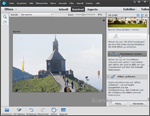
The tilt-effect of elements can, if used sparsely, be used for other effects. In the example picture, it has the effect of unsharp masking, affecting the skies, the roof of the chapel and the paratrooper. It looks almost like the right image section was befogged. During three, the user is guided by the software's assistant, leading to the desired result. The first step is entirely automatic - the software chooses an image section and applies the tilt-shift-effect to this section. In the next step, the focal area can be altered, i.e. the area that the tilt-shift-effect has been applied to can be altered by drawing a line with the mouse. The sharpness gradient will then be aligned with this line. In the third step, the effect can be further refined. For this purpose, several controls are at the user's commad by which diffusion, contrast and saturation can be manually influenced.
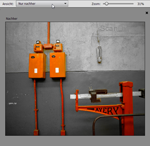
Adobe® promotes the new effect "color-pop", by means of which, images can be partially desaturated, as a big highlight of Version 13. We tried the filter in the "assistant" mode and to our entire satisfaction, it delivers on it's promise. It's easy as pie to desaturate individual channels. The result is especially impressive with pictures containing concise color fields. During the process, every step is comprehensibly explained to the user. The final result is a black-and-white picture with partial color information.
Likewise, the user is being led through the process in three steps. First, the user has to choose the color that is supposed to ultimately remain in the black-and-white image. This can be accomplished in different ways. One way is by using four buttons - red, yellow, blue and green. Another way is by using a pipette tool. Furthermore, a tolerance slider offers further influence on the tonal range (bidirectionally). In the second step, the filter can be refined by utilizing the same tools deployed during the photomerge-composition (add, substract, move and smoothen). If required, in the third and final step, the saturation of the selected colors can be boosted, stepping up the "pop" effect.
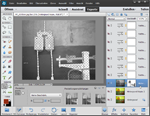
Switching from the mode "assistant" to the mode "expert" reveals the secrets happening behind the stage: the software arranges both layer and clipping masks on the working layer. Each and every brush stroke is thus saved seperately. This is very handy in practice since it enables the user to revoke or re-establish individual process steps retrospectively. In fact, this can be done independent of the chronological order!
Facebook-cover-pictures

Another newly introduced function of Photoshop® Elements can be found in the menu "create". Here, the user can prdocue cover-photos for facebook with a special layout. The idea is simple: integrating the profile picture in to the cover photo. Several themes are at disposal, presets with graphical elements such as picture frames, etc. The montage can consist of one or several images.
For doing this with a single picture, the following is needed: A picture showing oneself (or whatever else it is that shall be on display in the area of the profile photo on the facebook page), along with a suitable background. And this is precisely where it gets tricky, because the profile photo is located in the lower left corner of the image. In the process, size and cutout can be varied in the process, but even though it proves to be tricky to find a suitable combination of background and profile picture. If there's not enough horizontal leeway available, it simply won't fit. In practise, it turns out that most scenes dont make the grade. Rather, a picture has to custom-shot for this montage.
Further changes in Photoshop® Elements 13
Besides the previously described innovations, some small changes have been introduced with the change to version 13. For example, the effects have been re-catalogued and reworked, moreover, 19 unprecedented effects are available.
A change targeting the advanced user, which will most likely remain unnoticed by most users, are the layer styles. Outlines for layers can now be defined within, without and even centrical.
For creating new files, some new defaults have been introduced, such as the "scrapbook". They are consistently available for all locale.
The text-tool has been reworked to the effecta that the size of the text can now be adjusted using a double arrow, right next to the actual text field. This is more convenient than adjusting the size through entering numbers in the input field or choosing it from the dropdown menu.
According to Adobe®, thanks to the newly introduced eLive function, it's now possible to access tutorials and articles depending on the respective issue-area. As such, video seminars are available directly from within the help menu. With a click on the menu point, the website tv.adobe.com will open in the internet browser of choice. The video tutorials are present in english language but at the point of our test, covered only version 12 of Adobe® Photoshop® Elements. As all essential functions remained the same, this database is nevertheless a good hand.
In the newest Verison of the Software, some functions have been cancelled. This includes the photomerge-function "style-accordance".
System requirements
System requirements have naturally risen and an active internet connection is a must for product activation. Anyhow, the program will run on all versions of windows back to Version XP (SP3). Mac users will need at least Mac OS X 10.8. At least 5GB hard disc space and 2GB random access memory are necessary, cross platform.
Price and support
Especially users that need image editing software only for home use will be delighted to hear that Photoshop Elements is amongst the few Adobe® products that are still available without subscription fee (unlike Photoshop CC). Instead, after a single payment it can simply be used. In return, the telephone support for elements has been completetly axed and the remaining support-chat is english only.
Adobe® Photoshop® Elements 14
Photoshop® Elements 14 came out in autumn 2015, on schedule to replace Version 13 from last year. As expected, Adobe ® introduces some new functions with this release. In addition, Elements 14 offers functions we all know from earlier versions, which on the website of Adobe ®, are being portrayed and marketed in all their glory. The graphic interface has been modified just slightly, so look and feel are identic to version 11 and 12.
Blur reduction
Thanksk to this function, which Adobe® advertises as one of the major benefits of Version 14, blurred pictures are now a thing of the past. As cameras are getting smaller and lighter every year, the risk of blurred pictures has vastly increased. Moreover, the ever increasing amount of selfies - often taken with an outstretched arm, increases the percentage of shaky pictures further. This, as well as a lack of adjustment of parameters seen on cell phones and compact cameras, calls for a filter that will recover lost detail in said pictures.

In Photoshop® Elements 14, blur can be reduced at the click of the mouse, completely automatic. Alternatively, the user may adjust the blur reduction manually. To do this, a separate window, in which the sensitiviy can be adjusted through a controller, is opened. The impact can be judged in near realtime. Thanks to the pre-post comparison which can be accessed through a separate switch, one can easily compare between the filtered version and the original. The result of the automatic blur reduction does yield an apparent blur reduction, yet is not convincing to us.
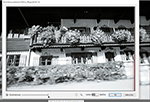
Through manual adjustment the impact of the filter can be lessened. If the sensitivity modulator is being set to maximum, the results will be the same as with the one-click variant. This setting surely does deliver the sharpest image - but it also yields the most artefacts. Some details of the original picture are being multiplied in the output.
Well then, does the filter keep a promise? Yes and no. The detection of the axis of blur is very reliebla. The image does indeed gain sharpness through sharpening of outlines. The actual Problem though, isn't remedied because the outcome is neither more impressive nor useful. What's more, fine tuning does not improve the results and will only cost you time.
Haze removal
As the name implies, this filter supposedly rids images of haze and fog. Landscape photos with marvellous silhouettes, crisp and clear even in subpar weather conditions? Sounds promising.

The user may choose between a fully automatic and a semiautomatic option. Whilst the former already yields astonishing results, vernier adjustment will lead to even better outcome. This is accomplished by carefully tuning the two modulators available in a separate dialogue. Here, intensity and haze regulation can be individually tuned. Thanks to a pre-post switch, the effects can be evaluated in real-time.

The modulator for dust removal works just as expected - with increasing intensity, edges and structure appear sharper. If you take a close look, you will see that this is accomplished by contrast enhancement as well as edge sharpening and also by a slight increase of saturation, notably in the blue channel. That's why, with increasing intensity, some detail is lost in the shadows and blacks. Given the overall impression, this is not too severe. For most themes, we recommend a governor setting within the upper third but below maximum.
The sensitivity of the dust recognition, set through the second modulator, is to be taken with a grain of salt. Within the lower third, modification appears relatively natural. If you go higher, things get extreme. Within the medium third, we did not see any real advantage in terms of image content. Instead, a very visible chroma increase took place in the skies. No change seems to take place upon puthsing the modulator further than this.
Let us note: this last function prooves to be very useful and feasible for a certain intended use. You missed out on the clear morning skies? You're lacking time, can't afford to stay for the perfect afternoon light? No problem! This filter works as praised and will save your misty pictures and add value to them.
Adobe® Photoshop® Elements 15
True to the annual rota, in autumn of 2016 Photoshop® Elements 15 was introduced to the market. For the 15th anniversary, Adobe® buckled down to make produce something extraordinary. In comparison to the earlier versions from previous years, version 15 does in fact offer a seminal improvement, which was inherited from the professional version of Photoshop®, Photoshop® CC. Besides, a ton of minor changes and improvemets have been made, although these do not carry weight. The graphic interface has barely been touched. Look and feel are very similar to that of the previous versions. The new filters of version 15 are very CPU-intensive, so that older computers break a sweat.
If you need Photoshop® Elements only for editing and optimizing your digital photos or your scans, you will quickly recognize, when going to the new features described in the following, that an update to the version 12 is not necessary and that you can accomplish your tasks with an older version as well.
Turn frowns upside down - thanks to the new facial recognition filter

This is the most significant innovation in Adobe® Photoshop® Elements version 15. With just a few clicks, frowns can be turned into joyful expressions. Though one must pay attention to certain details. First of all, the facial recognition works only moderately - and if no face is recognized, the filter cannot be used. Resolution and contrast need to be sufficient. In practice, this means: group shots with many faces are critical, unless the material in question is of extremely high resolution. If faces are shadowed, they are hardly recognized. Faces of African-Americans are often not recognized. Second, the filter works only until a certaion point. Third, the human mimic is rather complex - a grim face consists of many more details than just a snoot. Eyes, forehead, etc. are equally important to the overall perception. Since the filter primarily targets sagging mouths that are then turned into smiles, the results vary in conviction.
Wrinkles in the forehead cannot be removed with this filter. Size, form, twist of the eyes as well as the gap between can be changed - though this affects rather the general look than the expression. The same goes for the nose and the facial form; manipulation of these fall in the category of beauty retouching. In cases of beautiful faces, the latter can often go down the drain - with unhuman looking results. Only unproportional looks can be optimized in this regard. In the above picture, we primarily changed the mouth. Besides, size and angle of the eyes, width of the nose, and the form of the jaw bone have been slightly modified. To get some before and after impression, click the alongside picture.
New filter: Extract texts from pictures

We would like to go into another filter, which is promoted as a new function by Adobe®. Using this function, parts of pictures can be extracted in the form of texts. Actually, this filter is not new at all. Not only was it already been available in Photoshop®, even in old Versions of Microsoft Word one could do the same.

New is merely the ability to use this function as a separate, guided filter. The step by step instructions are available in the mode "assistant". In contrary to earlier Versions, the handling of individual layers is now simplified. In the alongside picture, a theme of a mountain range at sunset has been chosen. After choosing font and -size, the Text is simply typed onto the theme. Finally, the borders of the font can be smoothened, and one can choose to blacken, whiten or remove (make lucent) the remaining image content. Enclosed is a screenshot, illustrating the magic behind scenes.
Besides the depicted filters, some additional innovations have been made with Adobe® Photoshop® Elements Version 15. These are divided into improvements of automation and improvements of organisation - and machining sequences.
Improvements in image editing
You can now bring collages to life, especially if you're working with both Adobe® Photoshop® Elements Version 15 and Premiere® Elements Version 15. This filter enables the user to create not only photo- but also video collages. Just as Extracts from pictures, this filter offers a step by step guide. According to the press statement of Adobe®, Signature looks is one of the filters aiming to support the users creativiy. It also comes with a step by step guidance and lets the user mix several effects in one single image. Adobe® Photoshop® Elements Version 15 for the first time lets the user combine several effects; this has not been supported previously.
Pump up the action is another new filter. Using it, the background of images can be blurred, creating a panning look. The filter photo painting lets you draw effects on the pictures, add structures and use color palettes. While this is marketed as an innovation, it really just is an improvement. Lastly, frames can be completely customized using a step by step guide.
Improvements in organizing and administration
These innovations concern the Adobe® Elements Oranizer, that is the file browser of elements. Since Version 15, the latter is touch enabled, meaning the handling of the sorting- and search functions is tuned to the operation of touchscreen devices. Furthermore, the search functionality has been improved. Now, the user may search by means of additional criteria, such as certain events, places and locations. This is all thanks to the smart tags function of the program, which - sadly - is not always reliable. Additional, neat tagging by the user is hardly expendable. Also, the instant Fix has been improved: simple adjustments can now be adapted to entire batches of images. In the field, this might well be the most handy feature of the lot; at least if a series of pictures has been made in the same or similar light conditions. It can be a huge time saver.
Adobe® Photoshop® Elements 2018
Every year in automn one expects the new Photoshop® Elements version. So it was in autumn 2017, the new version with the name Photoshop® Elements 2018 came up. It was clear, that there would not be larger changes in this year, too. There are only 4 new features and 4 new How-tos, i.e. instructions with an assisstant which lead the user through a specific work flow. Furthermore the functions Automatic sorting and Simple publication were extended. Since both the How-tos and the extended functions are rather neglectible, we will concentrate on the new features and explain them in more detail in the following.
If you use Photoshop® Elements just for editing and optimizing your digital photos or your scans you will quickly realize when looking at the new features in the following, that an upgrade to the new version 2018 is not neccessary and that you can do your job also with an older version starting with version 8.
In the following we will present the changes at the version 2018 shortly. The most essential and epoch-making change after more than 10 years of Photoshop® is the designation of the new version: Whilst up to now the versions were counted continuously from 1 to 15, now a new numbering seems to start: The version number is the year which follows the release year. So in the the year 2017 the version 2018 comes to the market. Next year we will expect the version 2019.
Automatic selection
This function deals with the automatic selection of image areas. Just by a raw choice Adobe® Photoshop® Elements 2018 can find the desired field of the motive and thus facilitates the editing of a specific image field.

You find the automatic selection in the tool bar. Here you find next to the well-known magic stick, which has a star at its peak, the new automatic selection stick, which has 3 stars on it. If you have chosen this tool, you can select the desired image area by pulling a rectangle with the mouse.

If you click at the adjacent picture an animation opens which demonstrates the process of automatic selection. In our example we want to select the bloom and the buds of the rose in order to change an apricot rose into a rosé rose. So we make the selection area directly arount the desird rose bloom and after finishing the mouse click the selection area automatically lies around the desired motive. No this area can changed in colours. Then you unselect the area and you are done. How good this automatic selection method works of course depends on the background of the image.
Open close eyes like magic
Every photographer knows closed eyes on photos. Whilst you just repeat the photo if you make a posed photo, it is more difficult if you make a snapshot photo. You cannot just repeat a momental picture. So you have to open the eyes in the image processing step afterwards. Photoshop® Elements 2018 offers a function, which opens closed eyes automatically. The software chooses from several photos of similar posings the missing open eyes and replaces them in the picture with the closed eyes. Troublesome cutting and adapting is not neccessary within this step.
Dynamic slide shows
Digital photos and videso should not fall into oblivion on your hard drive. In order to present your photos Adobe® Photoshop® Elements 2018 offers the feature of dynamic slide shows. This feature makes a show by combining photos, videos, cross-fading effects and colour filters. So you can make a souvenir for any holiday trip or birthday party, which you can look at again and again and show it to your familiy or your friends.
Automatic combination of your best photos
This new function is integrated in the organizer of Adobe® Photoshop® Elements 2018. The best photos are chosen automatically by criteria like quality, faces, motives and photo tags.
Back to the index Software Tests
Author: Marcus Schrandt, Patrick Wagner
|